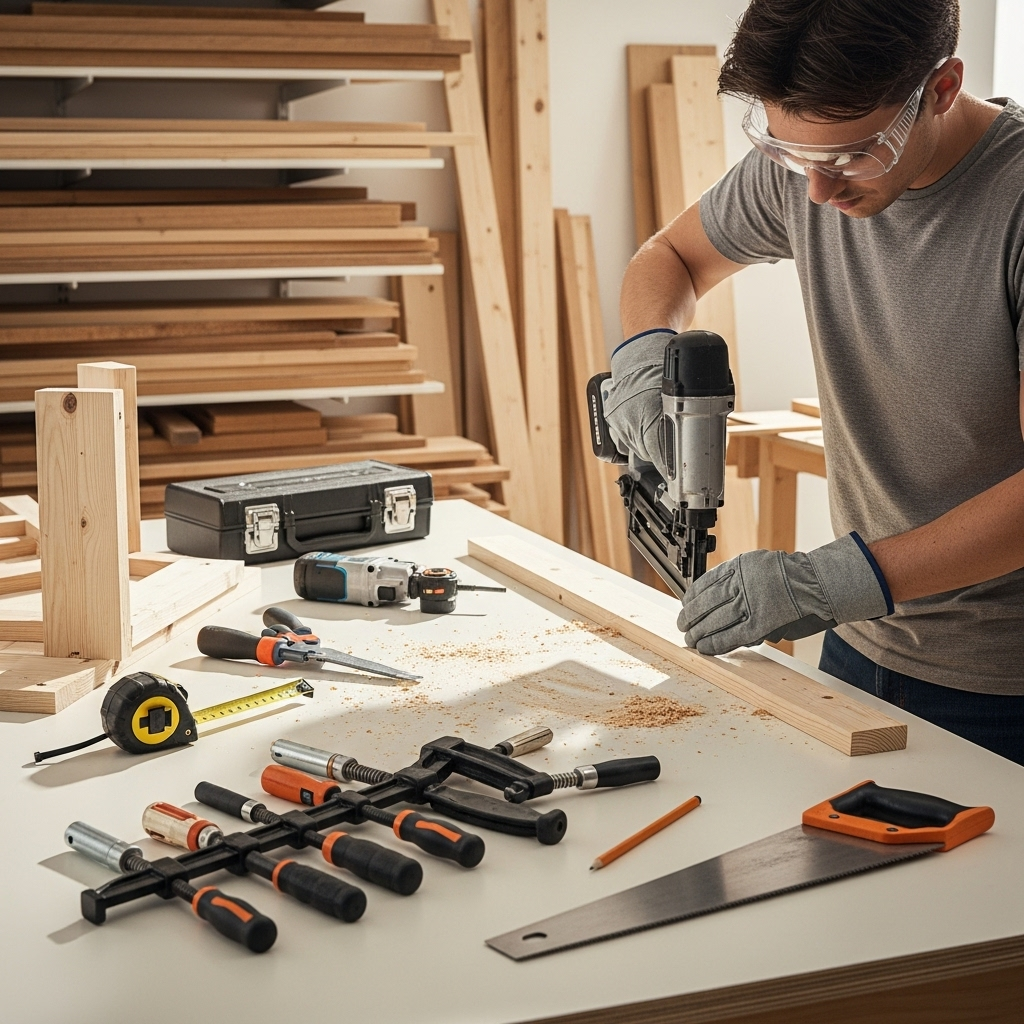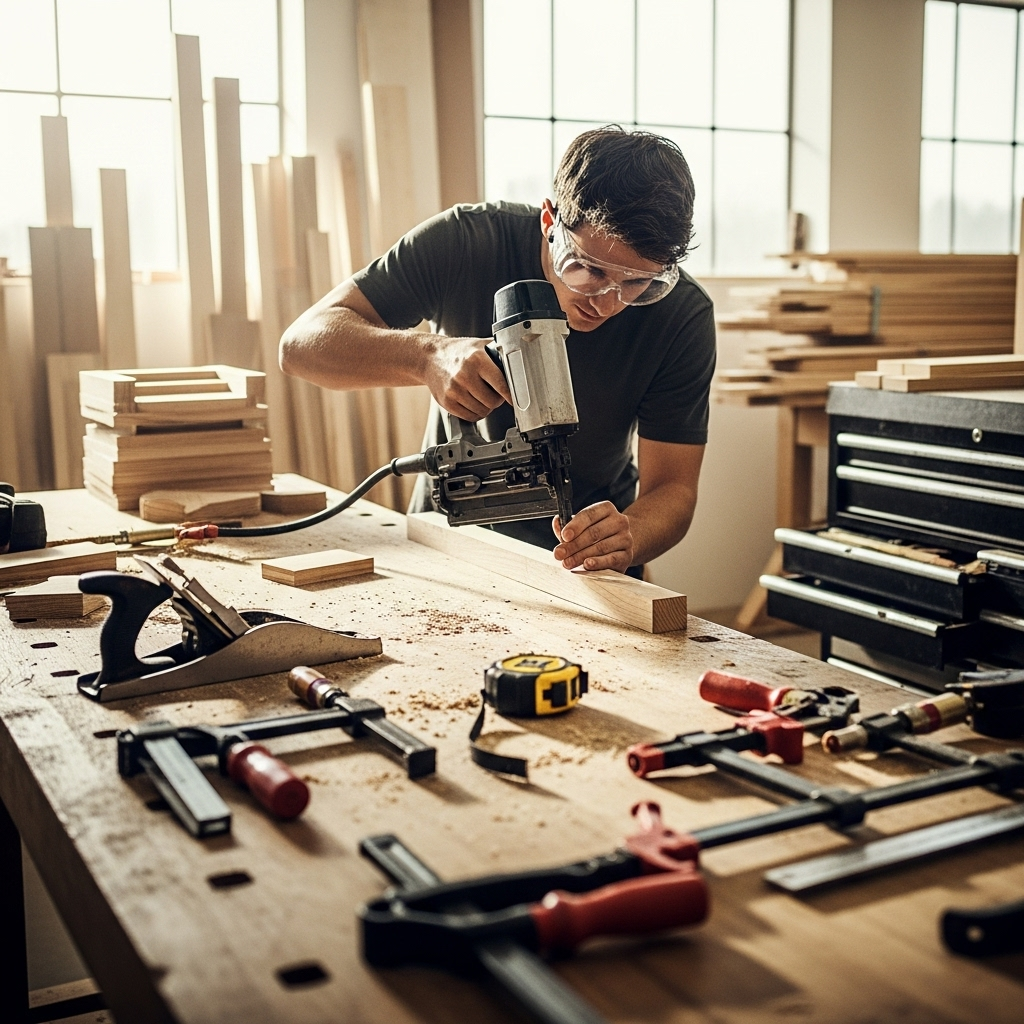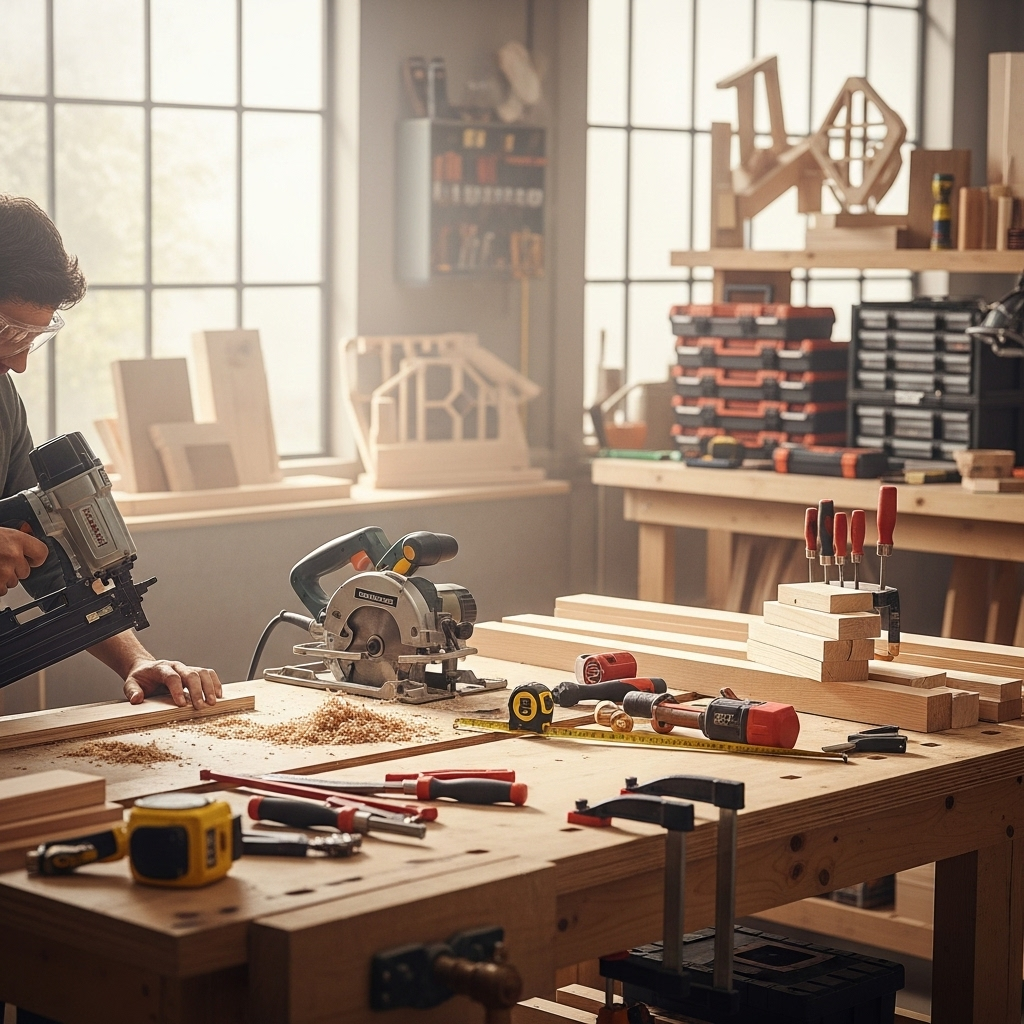Build a beautiful backyard wooden swing with our easy-to-follow DIY plan. Perfect for beginners, this guide provides step-by-step instructions, a complete tool list, and helpful tips to create a sturdy and inviting swing that your family will love for years to come. Get ready to transform your backyard into a fun oasis!
Dreaming of a cozy spot in your backyard where you can relax, read a book, or just enjoy the gentle sway? A wooden swing can be that perfect addition! But it might seem like a big project, especially if you’re new to woodworking. Don’t let that stop you! We’re here to break down creating your own backyard wooden swing into simple, manageable steps.
This guide is designed for you. You’ll find a clear woodworking plan, a list of essential tools and materials, and plenty of advice to help you build with confidence. By the end, you’ll have a beautiful, handcrafted swing that adds charm and fun to your outdoor space. Let’s get building!
Table of Contents
Your Backyard Wooden Swing Woodworking Plan: The Ultimate DIY Guide
There’s something truly special about a handcrafted wooden swing. It’s more than just a place to sit; it’s a symbol of relaxation, family fun, and your own handy work. Getting started with a woodworking project like this might feel a bit daunting, but with the right plan and a little guidance, it’s entirely achievable. Nailerguy is here to equip you with everything you need to know to build a durable, safe, and aesthetically pleasing wooden swing for your backyard.
This guide will cover:
- The essential tools and materials you’ll need.
- A comprehensive step-by-step breakdown of the building process.
- Tips for choosing the best wood and ensuring longevity.
- Safety considerations every DIYer should keep in mind.
- How to personalize your swing to match your style.
Let’s dive into creating a backyard centerpiece that will bring joy for seasons to come!
Choosing Your Perfect Wood for the Swing

The type of wood you choose for your swing is crucial. It impacts durability, appearance, and how easy it is to work with. For outdoor projects like swings, you need wood that can withstand the elements – rain, sun, wind, and even snow. Cedar and redwood are excellent choices because they are naturally resistant to rot and insects. Pine is a more budget-friendly option, but it requires good sealing and regular maintenance to last.
Here’s a quick look at some popular woods:
| Wood Type | Pros | Cons | Typical Cost |
|---|---|---|---|
| Cedar | Naturally rot and insect resistant, lightweight, attractive scent, easy to work with. | More expensive than pine, can be soft and prone to denting. | $$$ |
| Redwood | Highly resistant to rot and insects, very stable, beautiful deep color. | Most expensive, can be prone to warping if not properly dried. | $$$$ |
| Pressure-Treated Pine | Economical, readily available, good resistance to rot and insects. | Can contain chemicals (ensure it’s rated for ground contact if applicable, though not for your swing structure here), can warp or crack, requires sealing. | $$ |
| White Oak | Very durable, strong, good resistance to rot. | Heavy, can be more difficult to work with, requires sealing. | $$$ |
For this plan, we’ll assume you’re using a weather-resistant wood like cedar or pressure-treated pine. Always ensure your lumber is straight and free from major knots or cracks.
Essential Tools and Materials: Your Swing Building Toolkit
Before you grab your lumber, let’s make sure you have all the right tools and materials. Having everything ready will make your project go smoothly and safely. This list is geared towards beginners, with common tools you might already have or can easily acquire.
Tools You’ll Need:
- Measuring Tape: For accurate measurements.
- Pencil: For marking cut lines.
- Safety Glasses: Absolutely essential to protect your eyes.
- Hearing Protection: Especially when using power saws.
- Work Gloves: To protect your hands.
- Saw: A circular saw or a miter saw is ideal for clean cuts. A handsaw can work but will take more effort.
- Drill/Driver: For pre-drilling holes and driving screws.
- Drill Bits: Various sizes, including a countersink bit.
- Sander: An orbital sander or sanding block with sandpaper (80-grit and 150-grit).
- Clamps: To hold pieces together while you work.
- Level: To ensure your swing frame is plumb and stable.
- Square: A speed square or combination square for marking and checking 90-degree angles.
Materials You’ll Need:
- Lumber for the frame (e.g., 4×4 posts, 2×6 beams, 2×8 seat supports) – specific dimensions will be in the plan section.
- Lumber for the seat and back (e.g., 1×6 or 2×6 planks).
- Deck screws or exterior-grade wood screws (e.g., 2.5-inch and 3-inch). These are crucial for holding everything together securely outdoors.
- Carriage bolts, washers, and nuts (if required by the plan for extra strong joints).
- Rope or chain for hanging the swing (ensure it’s rated for outdoor use and can support significant weight).
- Eye bolts or screw hooks for attaching the rope/chain to the swing frame.
- Wood sealant or exterior-grade paint/stain (optional, but recommended for longevity).
- Sandpaper (various grits).
A word on fasteners: Always choose exterior-grade screws and hardware. Standard indoor screws will rust and weaken over time, posing a safety risk. For critical connections, consider using galvanized or stainless steel carriage bolts with washers and lock nuts. Check out resources on fastener types at WoodworkingTalk for more insights.
The Backyard Wooden Swing Plan: Step-by-Step Construction

This plan is designed for a classic, sturdy wooden swing. We’ll break it down into sections: the frame and the seat. Remember to measure twice and cut once!
Section 1: Building the Swing Frame
The frame is the backbone of your swing. It needs to be strong and stable. We’ll build a simple A-frame swing stand that’s easy to assemble and provides excellent support.
Materials for Frame:
- (4) 8-foot 4×4 posts (for legs)
- (2) 5-foot 2×6 boards (for top cross braces)
- (1) 4-foot 2×6 board (for center brace)
- (2) 3-foot 2×4 boards (for feet support or base extensions – optional, for added stability)
- 3-inch exterior-grade screws or lag bolts
- Carriage bolts (e.g., 6-inch, 1/2-inch diameter) with nuts and washers
Steps:
- Cut Your Lumber:
- From your 8-foot 4x4s, measure and cut two pieces to 7 feet long. These will be your main upright legs.
- From the remaining 4×4, cut two pieces to 4 feet long.
- Cut your 2×6 boards: two at 5 feet and one at 4 feet.
- Cut your 2×4 boards (if used) to 3 feet.
- Prepare the Legs:
Take the two 7-foot 4×4 legs. At the top end of each leg, measure in about 6 inches from one edge and mark a center point. This is where the top cross brace will attach.
- Attach Top Cross Braces:
Place one 5-foot 2×6 board across the top ends of the two 7-foot 4×4 legs. Ensure the ends of the 2×6 are flush with the outside edges of the 4x4s. Pre-drill and attach with 3-inch screws or lag bolts. Repeat for the other side using the second 5-foot 2×6.
- Add the Center Brace:
Now, take your 4-foot 2×6 center brace. Position it horizontally between the two A-frame legs, about 2 feet down from the top cross braces. This adds significant stability. Pre-drill and attach it securely to each 4×4 leg with 3-inch screws. Make sure it’s level.
- Reinforce with Carriage Bolts (Recommended):
For maximum security, consider reinforcing the main joints. At the top where the 2x6s meet the 4x4s, drill through the 4×4 and the 2×6. Insert a 1/2-inch carriage bolt with a washer on each side and secure with a nut. Do this for all four top connections.
- Add Feet Supports (Optional):
If you want extra stability, attach the 3-foot 2x4s diagonally from the bottom of each 4×4 leg upwards and inwards to the center brace. This forms a wider base. Screw them in securely.
- Install Hanging Hardware:
Decide where you want to hang your swing. Typically, this is from the center of the top cross braces. Install heavy-duty eye bolts or screw hooks into the underside of the 2×6 top braces. Make sure they are screwed in deep enough to be secure, and consider adding washers and nuts on the top side of the brace for extra reinforcement. If using screw eye hooks, ensure the wood is thick enough for them to grip well.
Section 2: Building the Swing Seat
This is where your swing starts to look like a seat! We’ll build a simple, comfortable plank-style seat.
Materials for Seat:
- (2) 4-foot 2×6 boards (for seat base)
- (3-4) 3-foot 1×6 or 2×6 boards (for seat slats)
- (2) 4-foot 1×6 or 2×6 boards (for backrest)
- (2) 2-foot 1×4 or 2×4 boards (for armrests – optional)
- 2.5-inch exterior-grade screws
- Eye bolts or attachment hardware for hanging ropes/chains
Steps:
- Construct the Seat Base:
Take your two 4-foot 2×6 boards and lay them parallel, 4 feet apart. These will form the main supports for your seat and backrest. You can space them slightly apart if you want a wider seat, but for simplicity, we’ll keep them at 4 feet for now.
- Attach Seat Slats:
Place your 3-foot seat slat boards across the two 4-foot base boards. Space them evenly, leaving a small gap (about 1/4 inch) between each slat for drainage. Pre-drill and secure each slat to the base boards with 2.5-inch screws. Aim for two screws per slat on each end.
- Build the Backrest:
Take your two 4-foot 1×6 or 2×6 boards. Position them vertically against the back of the seat base boards, forming your backrest. You can adjust the angle slightly for comfort; a gentle lean is usually best. Pre-drill and secure these backrest boards to the seat’s base boards with 2.5-inch screws. You might want to use 3-inch screws for this connection as it’s a critical joint.
- Add Armrests (Optional):
If you want armrests, attach the 2-foot 1×4 or 2×4 boards to the outside of the seat base boards, extending upwards to where the backrest begins. Secure them firmly with screws. These add a nice touch and extra comfort.
- Sand Smooth:
Once assembled, thoroughly sand all edges and surfaces. Start with 80-grit sandpaper to smooth out any rough spots and remove splinters, then finish with 150-grit for a nice, smooth feel. This is especially important on the seat and backrest.
- Install Hanging Hardware on Seat:
On each end of the seat base boards (the 4-foot 2x6s), install eye bolts or similar hardware where you will attach the ropes or chains for hanging. Ensure these are securely fastened and can bear weight. You’ll want two attachment points on the front and two on the back, or at least two strong points where the main hanging ropes will connect.
Section 3: Hanging Your Swing
This is the final, exciting step! Make sure you have a strong overhead support – a sturdy tree branch or a reinforced beam. If hanging from a tree, ensure the branch is healthy and thick. If using a pre-made swing frame, follow its instructions. If suspending from a porch or pergola, confirm the structure can handle the dynamic load of a swinging weight.
Steps:
- Measure and Cut Rope/Chain:
Determine the desired height of your swing. You’ll need enough rope or chain to reach from your overhead support to the swing’s hanging hardware, plus extra for knots or adjustment. It’s usually best to have the seat about 18-24 inches off the ground when at rest.
- Attach to Overhead Support:
Securely attach one end of your rope or chain to the overhead support. Use appropriate hardware for the support type (e.g., heavy-duty straps for tree branches, robust screw hooks for beams).
- Connect to Swing:
Thread the other end of the rope or chain through the eye bolts on your swing seat. Secure it with strong knots (like a bowline knot if using rope, and consider a stopper knot below it) or by using appropriate chain connectors.
- Level and Adjust:
Hang the swing and check that it’s level. Adjust the rope/chain lengths as needed. Make small adjustments to ensure the swing hangs evenly and safely.
- Test for Safety:
Before anyone sits on it, give the swing a good test. Sit on it yourself first, apply your weight gently, and then swing lightly. Listen for any creaks or signs of strain. You can find comprehensive swing hanging guides and safety checklists from organizations like The Consumer Product Safety Commission (CPSC) for valuable safety insights.
Finishing and Protecting Your Wooden Swing
Once your swing is built and hanging, you’ll want to protect your hard work and make it last. Even if you used naturally resistant wood, a good finish provides an extra layer of defense against the elements and enhances its appearance.
Sanding:
- Make sure all surfaces are smooth. Go over everything one last time with 150-grit or 220-grit sandpaper, paying attention to edges and areas that will come into contact with skin. Wipe away all dust with a clean cloth or tack cloth.
Sealing and Staining/Painting:
- Sealant: A clear exterior-grade sealant is a great option if you want to preserve the natural look of the wood. Apply at least two coats, following the product’s instructions for drying times.
- Stain: If you want to add color while still letting the wood grain show, an exterior stain is the way to go. Apply evenly and wipe off any excess.
- Paint: For a solid color, use exterior-grade paint. Two coats are usually recommended for good coverage and durability.
Important Considerations:
- Always choose products specifically designed for outdoor use.
- Apply finishes in a well-ventilated area, away from direct sunlight or extreme temperatures.
- Allow the finish to cure completely according to the manufacturer’s instructions before allowing anyone to use the swing. This can take several days for some products.
Tips for a Successful and Safe Swing Project

Building your own swing is a rewarding project. Here are a few extra tips from an old hand to help you along the way:
- Pre-Drill Everything: This is probably the most important tip for woodworking. Pre-drilling pilot holes prevents wood from splitting, especially near the ends of boards, and makes driving screws much easier. Use a drill bit that’s slightly smaller than the diameter of your screw threads.
- Countersink Your Screws: For a cleaner look, use a countersink bit after pre-drilling. This creates a small recess so the head of the screw sits flush with or just below the surface of the wood.
- Work on a Level Surface: When assembling the frame and seat, try to do it on a flat, level surface. This ensures your pieces fit together squarely and your finished product isn’t warped.
- Get Help When Needed: Some steps, like holding large pieces of lumber or lifting the finished swing, are much easier and safer with an extra pair of hands.
- Regular Maintenance: Even the best-built swings need a little TLC. Periodically check for loose screws, bolts, or rope/chain connections. Reapply finishes every year or two as needed to keep your swing looking great and protected.
- Weight Capacity: Always consider the weight capacity of your chosen hardware and lumber. This plan is for a standard recreational swing; if you plan for multiple people or very heavy use, you’ll need to beef up the structure and hardware accordingly.
Frequently Asked Questions About Backyard Wooden Swings
Here are some common questions beginners have when planning their wooden swing project.
Q1: How much wood do I need for a simple wooden swing?
A: The exact amount depends on your chosen design, but for a basic A-frame stand and a plank seat like the one described, you’ll likely need around 40-50 linear feet of 4×4, 2×6, and 1×6 lumber. It’s always a good idea to buy slightly more than your calculated needs to account for mistakes or the best cuts.
Q2: What’s the best way to hang a swing from a tree?
A: For tree hanging, use heavy-duty, long eye bolts specifically designed for trees, or strong, wide straps that wrap around the branch without damaging the bark. Avoid simply tying rope directly to the branch, as this can girdle and kill the tree over time. Ensure the branch you choose is alive, healthy, and at least 8-10 inches in diameter.
Q3: Do I need to seal pressure-treated wood?
A: Yes, you should! While pressure-treated wood is resistant to rot and insects, sealing it provides an extra barrier against moisture and UV rays, which can still cause weathering, cracking, and warping. A good exterior-grade stain or sealant will protect it further.
Q4: How far apart should the hanging points on the swing be?
A: For a comfortable and stable swing, the hanging points on the swing itself should typically be about 18-24 inches apart. This aligns with where you’d install your seat base boards and ensures good balance.
Q5: What’s the difference between screws and lag bolts?
A: Lag bolts are essentially large screws with a hex head, designed for heavy-duty applications that require significant clamping force. They are often used for joining large timbers. Standard wood screws are smaller and used for general woodworking. For your swing frame, using lag bolts with washers for critical structural joints (like where the 4x4s meet the 2x6s) can add substantial strength.
Q6: How often should I check the safety of my swing?
A: It’s wise to perform a visual safety check at least once a month, especially after periods of heavy use or strong weather. More thorough checks of hardware tightness and wood integrity should be done at the beginning and end of each swing season (yearly).
Conclusion: Your Backyard Awaits Its New Favorite Spot

You’ve got the plan, the tools, and the know-how, and soon you’ll have a beautiful, durable wooden swing that you built yourself! This project is a fantastic way to add character and a fun focal point to your backyard. Remember to take your time, prioritize safety, and enjoy the process of creating something with your own hands.
Building this swing isn’t just about the finished product; it’s about the satisfaction of a job well done. Imagine the memories to be made – kids giggling as they swing high, quiet afternoons spent reading, or simply enjoying a gentle breeze. Your handcrafted swing will be at the heart of it all.
So gather your lumber, measure carefully, and get ready to build. You’re capable of creating a wonderful addition to your home that will be cherished for years. Happy building, Nailerguy style!